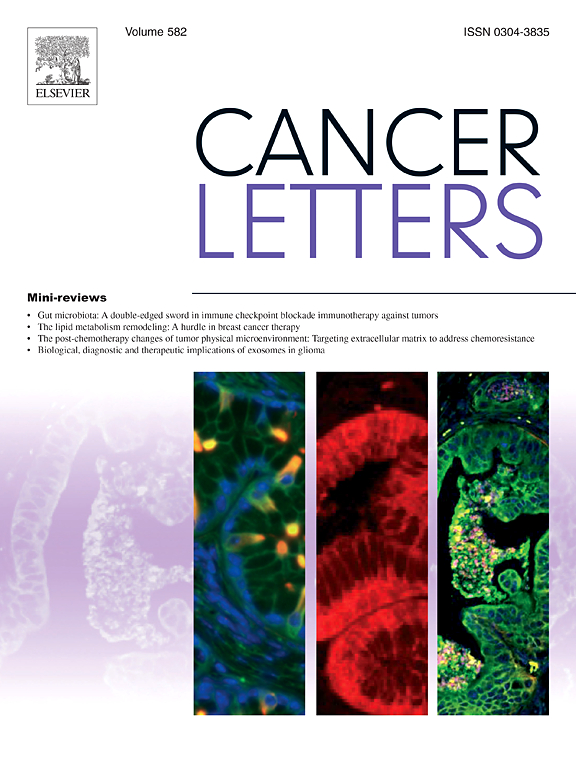前列腺癌染色体外环状DNA的分析和表征:从尿液、血浆和肿瘤样本中发现潜在的生物标志物
IF 9.1
1区 医学
Q1 ONCOLOGY
引用次数: 0
摘要
染色体外环状DNA (eccDNA)可能有助于基因组重排和肿瘤异质性,在癌症的发生和进展中发挥作用。本研究通过在不同疾病阶段患者的尿液、血浆和肿瘤组织中表征eccDNA的特征来评估其作为前列腺癌的生物标志物。我们研究了49例前列腺癌患者(23例早期;晚期前列腺炎26例(其中转移19例),前列腺炎23例,健康人21例。使用Circle-Map工作流程从血浆、尿液和肿瘤组织中提取EccDNA。我们分析了eccDNA丰度、基因组起源、GC含量、长度分布和重复序列含量。使用Wilcoxon秩和检验评估这些组之间的差异,并基于eccDNA特征对癌症和非癌症进行了五种机器学习模型分类。在不同的样本类型和疾病状态中观察到eccDNA水平的显著差异。与血浆和尿液样本相比,前列腺癌患者在肿瘤组织中表现出更高的eccDNA丰度。与非转移患者和对照组相比,转移患者血浆eccDNA水平显著升高。肿瘤来源的eccDNA具有较高的GC含量和明显的长度分布。不同组织类型共享的eccDNA分子提示了癌症发展的共同起源和潜在的系统性作用。分类模型取得了很强的性能,特别是在血浆中,神经网络模型的AUC达到了0.91,在尿液中,随机森林模型达到了0.77。局限性包括相对较小的队列规模和需要功能性研究来阐明eccDNA在癌症生物学中的作用。这项研究强调了eccDNA作为前列腺癌诊断和监测的非侵入性生物标志物的潜力。尿液、血浆和肿瘤组织中不同的eccDNA谱反映了疾病状态和进展,提示其在临床应用中的实用性。本文章由计算机程序翻译,如有差异,请以英文原文为准。
Analysis and characterization of extrachromosomal circular DNA in prostate cancer: Potential biomarker discovery from urine, plasma, and tumor samples
Extrachromosomal circular DNA (eccDNA) may contribute to genomic rearrangements and tumor heterogeneity, playing a role in cancer development and progression. This study evaluates eccDNA as a biomarker for prostate cancer by characterizing its profiles in urine, plasma, and tumor tissues from patients at different disease stages. We studied 49 prostate cancer patients (23 early-stage; 26 late-stage, including 19 with metastasis), 23 patients with prostatitis, and 21 healthy individuals. EccDNA was extracted from plasma, urine, and tumor tissues using the Circle-Map workflow. We analyzed eccDNA abundance, genomic origin, GC content, length distribution, and repetitive sequence content. Differences among these groups were assessed with the Wilcoxon rank-sum test, and five machine learning models classified cancer vs. non-cancer based on eccDNA features. Significant variations in eccDNA levels were observed among sample types and disease states. Prostate cancer patients exhibited higher eccDNA abundance in tumor tissues compared to plasma and urine samples. Metastatic patients had significantly elevated plasma eccDNA levels compared to nonmetastatic patients and controls. Tumor-derived eccDNA showed higher GC content and distinct length distributions. Shared eccDNA molecules across tissue types suggest common origins and potential systemic roles in cancer progression. Classification models achieved strong performance, especially in plasma, where a Neural Network model reached an AUC of 0.91, and in urine, where a Random Forest model reached 0.77. Limitations include the relatively small cohort size and the need for functional studies to clarify eccDNA's role in cancer biology. This study highlights eccDNA's potential as a noninvasive biomarker for prostate cancer diagnosis and monitoring. The distinct eccDNA profiles across urine, plasma, and tumor tissues reflect disease states and progression, suggesting its utility in clinical applications.
求助全文
通过发布文献求助,成功后即可免费获取论文全文。
去求助
来源期刊

Cancer letters
医学-肿瘤学
CiteScore
17.70
自引率
2.10%
发文量
427
审稿时长
15 days
期刊介绍:
Cancer Letters is a reputable international journal that serves as a platform for significant and original contributions in cancer research. The journal welcomes both full-length articles and Mini Reviews in the wide-ranging field of basic and translational oncology. Furthermore, it frequently presents Special Issues that shed light on current and topical areas in cancer research.
Cancer Letters is highly interested in various fundamental aspects that can cater to a diverse readership. These areas include the molecular genetics and cell biology of cancer, radiation biology, molecular pathology, hormones and cancer, viral oncology, metastasis, and chemoprevention. The journal actively focuses on experimental therapeutics, particularly the advancement of targeted therapies for personalized cancer medicine, such as metronomic chemotherapy.
By publishing groundbreaking research and promoting advancements in cancer treatments, Cancer Letters aims to actively contribute to the fight against cancer and the improvement of patient outcomes.
 求助内容:
求助内容: 应助结果提醒方式:
应助结果提醒方式:


